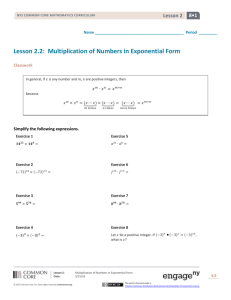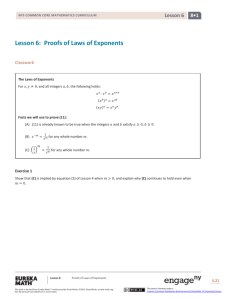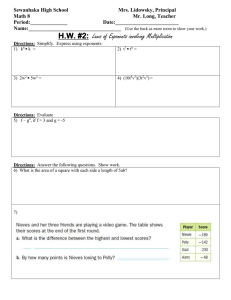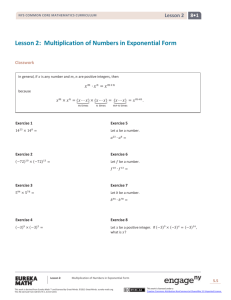Lesson 2: Multiplication of Numbers in Exponential Form
advertisement
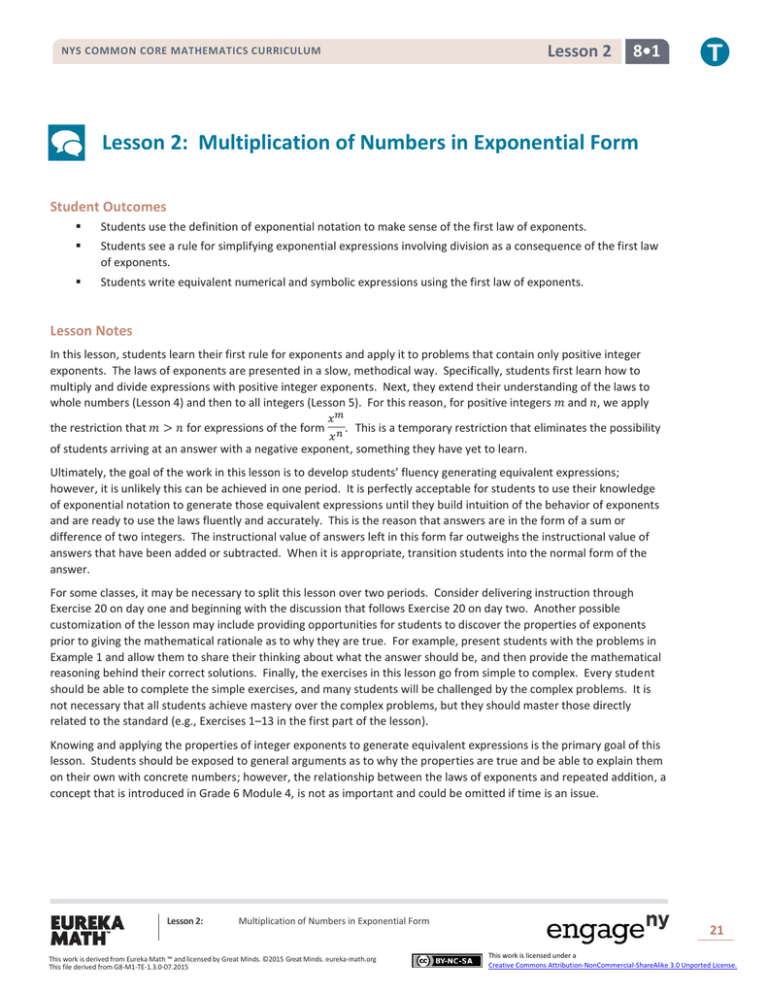
Lesson 2 NYS COMMON CORE MATHEMATICS CURRICULUM 8•1 Lesson 2: Multiplication of Numbers in Exponential Form Student Outcomes Students use the definition of exponential notation to make sense of the first law of exponents. Students see a rule for simplifying exponential expressions involving division as a consequence of the first law of exponents. Students write equivalent numerical and symbolic expressions using the first law of exponents. Lesson Notes In this lesson, students learn their first rule for exponents and apply it to problems that contain only positive integer exponents. The laws of exponents are presented in a slow, methodical way. Specifically, students first learn how to multiply and divide expressions with positive integer exponents. Next, they extend their understanding of the laws to whole numbers (Lesson 4) and then to all integers (Lesson 5). For this reason, for positive integers 𝑚 and 𝑛, we apply the restriction that 𝑚 > 𝑛 for expressions of the form 𝑥𝑚 𝑥𝑛 . This is a temporary restriction that eliminates the possibility of students arriving at an answer with a negative exponent, something they have yet to learn. Ultimately, the goal of the work in this lesson is to develop students’ fluency generating equivalent expressions; however, it is unlikely this can be achieved in one period. It is perfectly acceptable for students to use their knowledge of exponential notation to generate those equivalent expressions until they build intuition of the behavior of exponents and are ready to use the laws fluently and accurately. This is the reason that answers are in the form of a sum or difference of two integers. The instructional value of answers left in this form far outweighs the instructional value of answers that have been added or subtracted. When it is appropriate, transition students into the normal form of the answer. For some classes, it may be necessary to split this lesson over two periods. Consider delivering instruction through Exercise 20 on day one and beginning with the discussion that follows Exercise 20 on day two. Another possible customization of the lesson may include providing opportunities for students to discover the properties of exponents prior to giving the mathematical rationale as to why they are true. For example, present students with the problems in Example 1 and allow them to share their thinking about what the answer should be, and then provide the mathematical reasoning behind their correct solutions. Finally, the exercises in this lesson go from simple to complex. Every student should be able to complete the simple exercises, and many students will be challenged by the complex problems. It is not necessary that all students achieve mastery over the complex problems, but they should master those directly related to the standard (e.g., Exercises 1–13 in the first part of the lesson). Knowing and applying the properties of integer exponents to generate equivalent expressions is the primary goal of this lesson. Students should be exposed to general arguments as to why the properties are true and be able to explain them on their own with concrete numbers; however, the relationship between the laws of exponents and repeated addition, a concept that is introduced in Grade 6 Module 4, is not as important and could be omitted if time is an issue. Lesson 2: Multiplication of Numbers in Exponential Form This work is derived from Eureka Math ™ and licensed by Great Minds. ©2015 Great Minds. eureka-math.org This file derived from G8-M1-TE-1.3.0-07.2015 21 This work is licensed under a Creative Commons Attribution-NonCommercial-ShareAlike 3.0 Unported License. Lesson 2 NYS COMMON CORE MATHEMATICS CURRICULUM 8•1 Classwork Discussion (8 minutes) Scaffolding: We have to find out the basic properties of this new concept of raising a number to a power. There are three simple ones, and we will discuss them in this and the next lesson. (1) How to multiply different powers of the same number 𝑥: If 𝑚, 𝑛 are positive integers, what is 𝑥 𝑚 ∙ 𝑥 𝑛 ? Let students explore on their own and then in groups: 35 × 37 . Answer: 35 × 37 = (3 ⏟ × ⋯ × 3) × (3 ⏟ × ⋯ × 3) = (3 ⏟ × ⋯ × 3) = 35+7 5 times 7 times 5+7 times In general, if 𝑥 is any number and 𝑚, 𝑛 are positive integers, then 𝑥 𝑚 ∙ 𝑥 𝑛 = 𝑥 𝑚+𝑛 because (𝑥 ⋯ 𝑥) × ⏟ (𝑥 ⋯ 𝑥) = ⏟ (𝑥 ⋯ 𝑥) = 𝑥 𝑚+𝑛 . 𝑥𝑚 × 𝑥𝑛 = ⏟ 𝑚 times 𝑛 times Use concrete numbers for 𝑥, 𝑚, and 𝑛. This property was seen informally in Grade 7 through the use of units of measure for distance, area, and volume. For instance, in calculating the volume of a right prism, students multiplied the area of the prism’s base in 2 units times the height of the prism in units to get its 3 volume in units 2 (i.e., 𝑥 units × 𝑦 units 2+1 3 = 𝑥𝑦 units = 𝑥𝑦 units ). 𝑚+𝑛 times In general, if 𝒙 is any number and 𝒎, 𝒏 are positive integers, then Scaffolding: 𝒙𝒎 ∙ 𝒙𝒏 = 𝒙𝒎+𝒏 Advanced students may ask why 𝑚 and 𝑛 are restricted to positive integers. If so, ask them to consider some examples and what those examples might mean. For instance, if 𝑚 = 2 and 𝑛 = 0, then because (𝒙 ⋯ 𝒙) × ⏟ (𝒙 ⋯ 𝒙) = ⏟ (𝒙 ⋯ 𝒙) = 𝒙𝒎+𝒏 . 𝒙𝒎 × 𝒙𝒏 = ⏟ 𝒎 times 𝒏 times 𝒎+𝒏 times Examples 1–2 Work through Examples 1 and 2 in the manner just shown. (Supplement with additional examples if needed.) It is preferable to write the answers as an addition of exponents to emphasize the use of the identity. That step should not be left out. That is, 52 × 54 = 56 does not have the same instructional value as 52 × 54 = 52+4 . 3𝑚 ⋅ 3𝑛 = 32 ⋅ 30 = 32+0 = 32 . Interestingly, this means that 30 acts like the multiplicative identity 1. This idea is explored in Lesson 4. Example 1 Scaffolding: 52 × 54 = 52+4 Remind students that to remove ambiguity, bases that contain fractions or negative numbers require parentheses. Example 2 2 4 2 5 2 4+5 (− ) × (− ) = (− ) 3 3 3 Lesson 2: Multiplication of Numbers in Exponential Form This work is derived from Eureka Math ™ and licensed by Great Minds. ©2015 Great Minds. eureka-math.org This file derived from G8-M1-TE-1.3.0-07.2015 22 This work is licensed under a Creative Commons Attribution-NonCommercial-ShareAlike 3.0 Unported License. Lesson 2 NYS COMMON CORE MATHEMATICS CURRICULUM 8•1 What is the analog of 𝑥 𝑚 ∙ 𝑥 𝑛 = 𝑥 𝑚+𝑛 in the context of repeated addition of a number 𝑥? Allow time for a brief discussion. MP.2 & MP.7 If we add 𝑚 copies of 𝑥 and then add to it another 𝑛 copies of 𝑥, we end up adding 𝑚 + 𝑛 copies of 𝑥. By the distributive law: 𝑚𝑥 + 𝑛𝑥 = (𝑚 + 𝑛)𝑥 . This is further confirmation of what we observed at the beginning of Lesson 1: The exponent 𝑚 + 𝑛 in 𝑥 𝑚+𝑛 in the context of repeated multiplication corresponds exactly to the 𝑚 + 𝑛 in (𝑚 + 𝑛)𝑥 in the context of repeated addition. Exercises 1–20 (11 minutes) Have students complete Exercises 1–8 independently. Check their answers, and then have them complete Exercises 9– 20. Exercise 1 𝟐𝟑 𝟏𝟒 Exercise 5 𝟖 𝟐𝟑+𝟖 Let 𝒂 be a number. × 𝟏𝟒 = 𝟏𝟒 𝒂𝟐𝟑 ∙ 𝒂𝟖 = 𝒂𝟐𝟑+𝟖 Exercise 2 Exercise 6 (−𝟕𝟐)𝟏𝟎 × (−𝟕𝟐)𝟏𝟑 = (−𝟕𝟐)𝟏𝟎+𝟏𝟑 Let 𝒇 be a number. 𝒇𝟏𝟎 ∙ 𝒇𝟏𝟑 = 𝒇𝟏𝟎+𝟏𝟑 Exercise 3 Exercise 7 𝟓𝟗𝟒 × 𝟓𝟕𝟖 = 𝟓𝟗𝟒+𝟕𝟖 Let 𝒃 be a number. 𝒃𝟗𝟒 ∙ 𝒃𝟕𝟖 = 𝒃𝟗𝟒+𝟕𝟖 Exercise 4 (−𝟑)𝟗 × Exercise 8 (−𝟑)𝟓 = (−𝟑)𝟗+𝟓 Let 𝒙 be a positive integer. If (−𝟑)𝟗 × (−𝟑)𝒙 = (−𝟑)𝟏𝟒, what is 𝒙? 𝒙=𝟓 In Exercises 9–16, students need to think about how to rewrite some factors so the bases are the same. Specifically, 24 × 82 = 24 × 26 = 24+6 and 37 × 9 = 37 × 32 = 37+2 . Make clear that these expressions can only be combined into a single base because the bases are the same. Also included is a non-example, 54 × 211 , that cannot be combined into a single base using this identity. Exercises 17–20 offer further applications of the identity. What would happen if there were more terms with the same base? Write an equivalent expression for each problem. Exercise 9 Exercise 10 𝟗𝟒 × 𝟗𝟔 × 𝟗𝟏𝟑 = 𝟗𝟒+𝟔+𝟏𝟑 𝟐𝟑 × 𝟐𝟓 × 𝟐𝟕 × 𝟐𝟗 = 𝟐𝟑+𝟓+𝟕+𝟗 Lesson 2: Multiplication of Numbers in Exponential Form This work is derived from Eureka Math ™ and licensed by Great Minds. ©2015 Great Minds. eureka-math.org This file derived from G8-M1-TE-1.3.0-07.2015 23 This work is licensed under a Creative Commons Attribution-NonCommercial-ShareAlike 3.0 Unported License. Lesson 2 NYS COMMON CORE MATHEMATICS CURRICULUM 8•1 Can the following expressions be written in simpler form? If so, write an equivalent expression. If not, explain why not. Exercise 11 Exercise 14 𝟔𝟓 × 𝟒𝟗 × 𝟒𝟑 × 𝟔𝟏𝟒 = 𝟒𝟗+𝟑 × 𝟔𝟓+𝟏𝟒 𝟐𝟒 × 𝟖𝟐 = 𝟐𝟒 × 𝟐𝟔 = 𝟐𝟒+𝟔 Exercise 12 Exercise 15 (−𝟒)𝟐 ∙ 𝟏𝟕𝟓 ∙ (−𝟒)𝟑 ∙ 𝟏𝟕𝟕 = (−𝟒)𝟐+𝟑 ∙ 𝟏𝟕𝟓+𝟕 𝟑𝟕 × 𝟗 = 𝟑𝟕 × 𝟑𝟐 = 𝟑𝟕+𝟐 Exercise 13 Exercise 16 𝟏𝟓𝟐 ∙ 𝟕𝟐 ∙ 𝟏𝟓 ∙ 𝟕𝟒 = 𝟏𝟓𝟐+𝟏 ∙ 𝟕𝟐+𝟒 𝟓𝟒 × 𝟐𝟏𝟏 = Scaffolding: Some of these exercises can be written in several forms. The sample responses only provide one such form. Cannot be simplified. Bases are different and cannot be rewritten in the same base. Exercise 17 Let 𝒙 be a number. Rewrite the expression in a simpler form. (𝟐𝒙𝟑 )(𝟏𝟕𝒙𝟕 ) = 𝟑𝟒𝒙𝟏𝟎 Exercise 18 Let 𝒂 and 𝒃 be numbers. Use the distributive law to rewrite the expression in a simpler form. 𝒂(𝒂 + 𝒃) = 𝒂𝟐 + 𝒂𝒃 Exercise 19 Scaffolding: Remind students of the rectangular array used in Grade 7 Module 6 to multiply expressions of this form: Let 𝒂 and 𝒃 be numbers. Use the distributive law to rewrite the expression in a simpler form. 𝒃(𝒂 + 𝒃) = 𝒂𝒃 + 𝒃𝟐 Exercise 20 Let 𝒂 and 𝒃 be numbers. Use the distributive law to rewrite the expression in a simpler form. (𝒂 + 𝒃)(𝒂 + 𝒃) = 𝒂𝟐 + 𝒂𝒃 + 𝒃𝒂 + 𝒃𝟐 = 𝒂𝟐 + 𝟐𝒂𝒃 + 𝒃𝟐 (𝑎 + 𝑏)(𝑎 + 𝑏) = 𝑎2 + 𝑎𝑏 + 𝑏𝑎 + 𝑏 2 = 𝑎2 + 2𝑎𝑏 + 𝑏 2 Discussion (9 minutes) Now that we know something about multiplication, we actually know a little about how to divide numbers in exponential notation too. This is not a new law of exponents but a (good) consequence of knowing the first law of exponents. Make this clear to students. (2) We have just learned how to multiply two different positive integer powers of the same number 𝑥. It is time to ask how to divide different powers of a number 𝑥. If 𝑚 and 𝑛 are positive integers, what is Lesson 2: 𝑥𝑚 𝑥 ? 𝑛 Multiplication of Numbers in Exponential Form This work is derived from Eureka Math ™ and licensed by Great Minds. ©2015 Great Minds. eureka-math.org This file derived from G8-M1-TE-1.3.0-07.2015 Scaffolding: Use concrete numbers for 𝑥, 𝑚, and 𝑛. 24 This work is licensed under a Creative Commons Attribution-NonCommercial-ShareAlike 3.0 Unported License. Lesson 2 NYS COMMON CORE MATHEMATICS CURRICULUM 8•1 Allow time for a brief discussion. What is 37 35 ? (Observe: The power of 7 in the numerator is bigger than the Scaffolding: power of 5 in the denominator. The general case of arbitrary positive integer exponents will be addressed in Lesson 5, so all problems in this lesson will have greater exponents in the numerator than in the denominator.) Expect students to write 37 35 = 3∙3∙3∙3∙3∙3∙3 𝑚 3∙3∙3∙3∙3 𝑛 them to see how the formula 𝑥 ∙ 𝑥 = 𝑥 . However, we should nudge 𝑚+𝑛 comes into play. Answer: 37 35 = 35 ∙32 35 = 32 By 𝑥 𝑚 𝑥 𝑛 = 𝑥 𝑚+𝑛 By equivalent fractions = 37−5 Observe that the exponent 2 in 32 is the difference of 7 and 5 (see the numerator 35 ⋅ 32 on the first line). In general, if 𝑥 is nonzero and 𝑚, 𝑛 are positive integers, then: 𝑥𝑚 𝑥𝑛 Advanced students may ask about a case of the numerator and denominator having the same base, but the exponent of the denominator is greater than the exponent of the numerator. Write the numerator and denominator in expanded form, and then divide out their common factors. Students see that the remaining factors are in the denominator. This serves as an excellent opportunity to develop intuition with regard to the meaning of negative integer exponents. = 𝑥 𝑚−𝑛 The restriction on 𝑚 and 𝑛 given below is to prevent negative exponents from coming up in problems before students learn about them. If advanced students want to consider the remaining cases, 𝑚 = 𝑛 and 𝑚 < 𝑛, they can gain some insight to the meaning of the zeroth power and negative integer exponents. In general instruction however, these cases are reserved for Lessons 4 and 5. Let’s restrict (for now) 𝑚 > 𝑛. Then there is a positive integer 𝑙, so that 𝑚 = 𝑛 + 𝑙. Then, we can rewrite the identity as follows: 𝑥 𝑚 𝑥 𝑛+𝑙 = 𝑛 𝑥𝑛 𝑥 = 𝑥𝑛∙𝑥𝑙 𝑥𝑛 By 𝑥 𝑚 𝑥 𝑛 = 𝑥 𝑚+𝑛 = 𝑥𝑙 By equivalent fractions = 𝑥 𝑚−𝑛 Because 𝑚 = 𝑛 + 𝑙 implies 𝑙 = 𝑚 − 𝑛 Therefore, 𝑥𝑚 𝑥𝑛 = 𝑥 𝑚−𝑛 , if 𝑚 > 𝑛. In general, if 𝒙 is nonzero and 𝒎, 𝒏 are positive integers, then 𝒙𝒎 = 𝒙𝒎−𝒏 . 𝒙𝒏 Lesson 2: Multiplication of Numbers in Exponential Form This work is derived from Eureka Math ™ and licensed by Great Minds. ©2015 Great Minds. eureka-math.org This file derived from G8-M1-TE-1.3.0-07.2015 25 This work is licensed under a Creative Commons Attribution-NonCommercial-ShareAlike 3.0 Unported License. Lesson 2 NYS COMMON CORE MATHEMATICS CURRICULUM This formula is as far as we can go for now. The reason is that 35 37 8•1 in terms of exponents is 35−7 = 3−2 , and that answer makes no sense at the moment since we have no meaning for a negative exponent. This motivates our search for a definition of negative exponent, as we shall do in Lesson 5. What is the analog of MP.7 𝑥𝑚 𝑥𝑛 = 𝑥 𝑚−𝑛 , if 𝑚 > 𝑛 in the context of repeated addition of a number 𝑥? Division is to multiplication as subtraction is to addition, so if 𝑛 copies of a number 𝑥 is subtracted from 𝑚 copies of 𝑥, and 𝑚 > 𝑛, then (𝑚𝑥) − (𝑛𝑥) = (𝑚 − 𝑛)𝑥 by the distributive law. (Incidentally, observe once more how the exponent 𝑚 − 𝑛 in 𝑥 𝑚−𝑛 , in the context of repeated multiplication, corresponds exactly to the 𝑚 − 𝑛 in (𝑚 − 𝑛)𝑥 in the context of repeated addition.) Examples 3–4 Work through Examples 3 and 4 in the manner shown. (Supplement with additional examples if needed.) Scaffolding: It is preferable to write the answers as a subtraction of exponents to emphasize the use of the identity. Example 3 Example 4 3 8 8−6 ( ) 5 = (3) 5 3 6 ( ) 5 45 = 45−2 42 In Grade 3, students began recognizing division problems as missing factor problems. Students can relate that work to this work. For example: 45 42 = 4? is equivalent to missing factor problem 42 ⋅ 4? = 45 . Using the first law of exponents, this means 42+? = 45 , and ? = 3. Exercises 21–32 (11 minutes) Students complete Exercises 21–24 independently. Check their answers, and then have them complete Exercises 25–32 in pairs or small groups. Exercise 21 Exercise 23 𝟕 = 𝟕𝟗−𝟔 𝟕𝟔 𝟖 𝟗 𝟗−𝟐 ( ) 𝟓 = (𝟖) 𝟐 𝟓 𝟖 ( ) 𝟓 Exercise 22 Exercise 24 (−𝟓)𝟏𝟔 𝟏𝟑𝟓 = 𝟏𝟑𝟓−𝟒 𝟏𝟑𝟒 𝟗 (−𝟓)𝟕 = (−𝟓)𝟏𝟔−𝟕 Lesson 2: Multiplication of Numbers in Exponential Form This work is derived from Eureka Math ™ and licensed by Great Minds. ©2015 Great Minds. eureka-math.org This file derived from G8-M1-TE-1.3.0-07.2015 26 This work is licensed under a Creative Commons Attribution-NonCommercial-ShareAlike 3.0 Unported License. Lesson 2 NYS COMMON CORE MATHEMATICS CURRICULUM 8•1 Exercise 25 Let 𝒂, 𝒃 be nonzero numbers. What is the following number? Scaffolding: 𝒂 𝟗 𝟗−𝟐 ( ) 𝒃 = (𝒂 ) 𝟐 𝒂 𝒃 ( ) 𝒃 Try Exercise 25 as a missing factor problem (see scaffold box above) using knowledge of dividing fractions. Exercise 26 Let 𝒙 be a nonzero number. What is the following number? 𝒙𝟓 = 𝒙𝟓−𝟒 𝒙𝟒 Can the following expressions be written in simpler forms? If yes, write an equivalent expression for each problem. If not, explain why not. Exercise 27 𝟕 Exercise 29 𝟕 𝟐 𝟐 = = 𝟐𝟕−𝟒 𝟒𝟐 𝟐𝟒 𝟑𝟓 ∙ 𝟐𝟖 = 𝟑𝟓−𝟐 ∙ 𝟐𝟖−𝟑 𝟑𝟐 ∙ 𝟐𝟑 Exercise 28 Exercise 30 𝟐𝟑 𝟐𝟑 (−𝟐)𝟕 ∙ 𝟗𝟓𝟓 = (−𝟐)𝟕−𝟓 ∙ 𝟗𝟓𝟓−𝟒 (−𝟐)𝟓 ∙ 𝟗𝟓𝟒 𝟑 𝟑 = 𝟑 = 𝟑𝟐𝟑−𝟑 𝟐𝟕 𝟑 Exercise 31 Let 𝒙 be a number. Write each expression in a simpler form. a. b. c. 𝟓 𝒙𝟑 𝟓 𝒙𝟑 𝟓 𝒙𝟑 (𝟑𝒙𝟖 ) = 𝟏𝟓𝒙𝟓 (−𝟒𝒙𝟔 ) = −𝟐𝟎𝒙𝟑 (𝟏𝟏𝒙𝟒 ) = 𝟓𝟓𝒙 Exercise 32 Anne used an online calculator to multiply 𝟐 𝟎𝟎𝟎 𝟎𝟎𝟎 𝟎𝟎𝟎 × 𝟐 𝟎𝟎𝟎 𝟎𝟎𝟎 𝟎𝟎𝟎 𝟎𝟎𝟎. The answer showed up on the calculator as 𝟒𝐞 + 𝟐𝟏, as shown below. Is the answer on the calculator correct? How do you know? 𝟐 𝟎𝟎𝟎 𝟎𝟎𝟎 𝟎𝟎𝟎 × 𝟐 𝟎𝟎𝟎 𝟎𝟎𝟎 𝟎𝟎𝟎 𝟎𝟎𝟎 = 𝟒 𝟎𝟎𝟎 𝟎𝟎𝟎 𝟎𝟎𝟎 𝟎𝟎𝟎 𝟎𝟎𝟎 𝟎𝟎𝟎 𝟎𝟎𝟎. The answer must mean 𝟒 followed by 𝟐𝟏 zeros. That means that the answer on the calculator is correct. This problem is hinting at scientific notation (i.e., (𝟐 × 𝟏𝟎𝟗 )(𝟐 × 𝟏𝟎𝟏𝟐 ) = 𝟒 × 𝟏𝟎𝟗+𝟏𝟐). Accept any reasonable explanation of the answer. Lesson 2: Multiplication of Numbers in Exponential Form This work is derived from Eureka Math ™ and licensed by Great Minds. ©2015 Great Minds. eureka-math.org This file derived from G8-M1-TE-1.3.0-07.2015 27 This work is licensed under a Creative Commons Attribution-NonCommercial-ShareAlike 3.0 Unported License. NYS COMMON CORE MATHEMATICS CURRICULUM Lesson 2 8•1 Closing (3 minutes) Summarize, or have students summarize, the lesson. State the two identities and how to write equivalent expressions for each. Optional Fluency Exercise (2 minutes) This exercise is not an expectation of the standard, but it may prepare students for work with squared numbers in Module 2 with respect to the Pythagorean theorem. Therefore, this is an optional fluency exercise. Have students chorally respond to numbers squared and cubed that you provide. For example, you say “1 squared,” and students respond, “1.” Next, you say, “2 squared,” and students respond “4.” Have students respond to all squares, in order, up to 15. When squares are finished, start with “1 cubed,” and students respond “1.” Next, say “2 cubed,” and students respond “8.” Have students respond to all cubes, in order, up to 10. If time allows, have students respond to random squares and cubes. Exit Ticket (3 minutes) Lesson 2: Multiplication of Numbers in Exponential Form This work is derived from Eureka Math ™ and licensed by Great Minds. ©2015 Great Minds. eureka-math.org This file derived from G8-M1-TE-1.3.0-07.2015 28 This work is licensed under a Creative Commons Attribution-NonCommercial-ShareAlike 3.0 Unported License. Lesson 2 NYS COMMON CORE MATHEMATICS CURRICULUM Name ___________________________________________________ 8•1 Date____________________ Lesson 2: Multiplication of Numbers in Exponential Form Exit Ticket Write each expression using the fewest number of bases possible. 1. Let 𝑎 and 𝑏 be positive integers. 23𝑎 × 23𝑏 = 2. 53 × 25 = 3. Let 𝑥 and 𝑦 be positive integers and 𝑥 > 𝑦. 4. 213 23 11𝑥 11𝑦 = = Lesson 2: Multiplication of Numbers in Exponential Form This work is derived from Eureka Math ™ and licensed by Great Minds. ©2015 Great Minds. eureka-math.org This file derived from G8-M1-TE-1.3.0-07.2015 29 This work is licensed under a Creative Commons Attribution-NonCommercial-ShareAlike 3.0 Unported License. Lesson 2 NYS COMMON CORE MATHEMATICS CURRICULUM 8•1 Exit Ticket Sample Solutions Note to Teacher: Accept both forms of the answer; in other words, accept an answer that shows the exponents as a sum or difference as well as an answer where the numbers are actually added or subtracted. Write each expression using the fewest number of bases possible. 1. Let 𝒂 and 𝒃 be positive integers. 𝟐𝟑𝒂 × 𝟐𝟑𝒃 = 𝟐𝟑𝒂 × 𝟐𝟑𝒃 = 𝟐𝟑𝒂+𝒃 2. 𝟓𝟑 × 𝟐𝟓 = 𝟓𝟑 × 𝟐𝟓 = 𝟓𝟑 × 𝟓𝟐 = 𝟓𝟑+𝟐 = 𝟓𝟓 3. Let 𝒙 and 𝒚 be positive integers and 𝒙 > 𝒚. 𝟏𝟏𝒙 𝟏𝟏𝒚 = 𝟏𝟏𝒙 = 𝟏𝟏𝒙−𝒚 𝟏𝟏𝒚 4. 𝟐𝟏𝟑 𝟖 = 𝟐𝟏𝟑 = 𝟐𝟏𝟑−𝟑 = 𝟐𝟏𝟎 𝟐𝟑 Lesson 2: Multiplication of Numbers in Exponential Form This work is derived from Eureka Math ™ and licensed by Great Minds. ©2015 Great Minds. eureka-math.org This file derived from G8-M1-TE-1.3.0-07.2015 30 This work is licensed under a Creative Commons Attribution-NonCommercial-ShareAlike 3.0 Unported License. Lesson 2 NYS COMMON CORE MATHEMATICS CURRICULUM 8•1 Problem Set Sample Solutions To ensure success with Problems 1 and 2, students should complete at least bounces 1–4 with support in class. Consider working on Problem 1 as a class activity and assigning Problem 2 for homework. Students may benefit from a simple drawing of the scenario. It will help them see why the factor of 2 is necessary when calculating the distance traveled for each bounce. Make sure to leave the total distance traveled in the format shown so that students can see the pattern that is developing. Simplifying at any step will make it difficult to write the general statement for 𝑛 number of bounces. 1. 𝟐 A certain ball is dropped from a height of 𝒙 feet. It always bounces up to 𝒙 feet. Suppose the ball is dropped from 𝟑 𝟏𝟎 feet and is stopped exactly when it touches the ground after the 𝟑𝟎th bounce. What is the total distance traveled by the ball? Express your answer in exponential notation. Bounce Computation of Distance Traveled in Previous Bounce Total Distance Traveled (in feet) 1 𝟐 𝟐 ( ) 𝟏𝟎 𝟑 𝟐 𝟏𝟎 + 𝟐 ( ) 𝟏𝟎 𝟑 𝟐 𝟐 𝟐 [ ( ) 𝟏𝟎] 𝟑 𝟑 𝟐 𝟐 = 𝟐 ( ) 𝟏𝟎 𝟑 𝟐 𝟐 𝟐 𝟐 [ ( ) 𝟏𝟎] 𝟑 𝟑 𝟐 𝟑 = 𝟐 ( ) 𝟏𝟎 𝟑 𝟐 𝟐 𝟑 𝟐 [ ( ) 𝟏𝟎] 𝟑 𝟑 𝟐 𝟒 = 𝟐 ( ) 𝟏𝟎 𝟑 2 3 4 2. 𝟐 𝟐 𝟐 𝟏𝟎 + 𝟐 ( ) 𝟏𝟎 + 𝟐 ( ) 𝟏𝟎 𝟑 𝟑 𝟐 𝟐 𝟐 𝟐 𝟑 𝟏𝟎 + 𝟐 ( ) 𝟏𝟎 + 𝟐 ( ) 𝟏𝟎 + 𝟐 ( ) 𝟏𝟎 𝟑 𝟑 𝟑 𝟐 𝟐 𝟐 𝟐 𝟑 𝟐 𝟒 𝟏𝟎 + 𝟐 ( ) 𝟏𝟎 + 𝟐 ( ) 𝟏𝟎 + 𝟐 ( ) 𝟏𝟎 + 𝟐 ( ) 𝟏𝟎 𝟑 𝟑 𝟑 𝟑 30 𝟐 𝟑𝟎 𝟐 ( ) 𝟏𝟎 𝟑 𝟐 𝟐 𝟐 𝟐 𝟑 𝟐 𝟒 𝟐 𝟑𝟎 𝟏𝟎 + 𝟐 ( ) 𝟏𝟎 + 𝟐 ( ) 𝟏𝟎 + 𝟐 ( ) 𝟏𝟎 + 𝟐 ( ) 𝟏𝟎 + ⋯ + 𝟐 ( ) 𝟏𝟎 𝟑 𝟑 𝟑 𝟑 𝟑 𝒏 𝟐 𝒏 𝟐 ( ) 𝟏𝟎 𝟑 𝟐 𝟐 𝟐 𝟐 𝟐 𝒏 𝟏𝟎 + 𝟐𝟎 ( ) (𝟏 + ( ) + ( ) + ⋯ + ( ) ) 𝟑 𝟑 𝟑 𝟑 If the same ball is dropped from 𝟏𝟎 feet and is stopped exactly at the highest point after the 𝟐𝟓th bounce, what is the total distance traveled by the ball? Use what you learned from the last problem. 𝟐 𝟑 𝒏 Based on the last problem, we know that each bounce causes the ball to travel 𝟐 ( ) 𝟏𝟎 feet. If the ball is stopped 𝟐 𝟑 at the highest point of the 𝟐𝟓th bounce, then the distance traveled on that last bounce is just ( ) 𝟐𝟓 𝟏𝟎 feet because it does not make the return trip to the ground. Therefore, the total distance traveled by the ball in feet in this situation is 𝟐 𝟐 𝟐 𝟐 𝟑 𝟐 𝟒 𝟐 𝟐𝟑 𝟐 𝟐𝟒 𝟏𝟎 + 𝟐 ( ) 𝟏𝟎 + 𝟐 ( ) 𝟏𝟎 + 𝟐 ( ) 𝟏𝟎 + 𝟐 ( ) 𝟏𝟎 + ⋯ + 𝟐 ( ) 𝟏𝟎 + 𝟐 ( ) 𝟏𝟎. 𝟑 𝟑 𝟑 𝟑 𝟑 𝟑 Lesson 2: Multiplication of Numbers in Exponential Form This work is derived from Eureka Math ™ and licensed by Great Minds. ©2015 Great Minds. eureka-math.org This file derived from G8-M1-TE-1.3.0-07.2015 31 This work is licensed under a Creative Commons Attribution-NonCommercial-ShareAlike 3.0 Unported License. Lesson 2 NYS COMMON CORE MATHEMATICS CURRICULUM 3. 4. 8•1 Let 𝒂 and 𝒃 be numbers and 𝒃 ≠ 𝟎, and let 𝒎 and 𝒏 be positive integers. Write each expression using the fewest number of bases possible. (−𝟏𝟗)𝟓 ∙ (−𝟏𝟗)𝟏𝟏 = (−𝟏𝟗)𝟓+𝟏𝟏 𝟐. 𝟕𝟓 × 𝟐. 𝟕𝟑 = 𝟐. 𝟕𝟓+𝟑 𝟕𝟏𝟎 = 𝟕𝟏𝟎−𝟑 𝟕𝟑 𝟏 𝟐 𝟏 𝟏𝟓 𝟏 𝟐+𝟏𝟓 ( ) ∙( ) =( ) 𝟓 𝟓 𝟓 𝟗 𝒎 𝟗 𝒏 𝟗 𝒎+𝒏 (− ) ∙ (− ) = (− ) 𝟕 𝟕 𝟕 𝒂𝒃𝟑 = 𝒂𝒃𝟑−𝟐 𝒃𝟐 Let the dimensions of a rectangle be (𝟒 × (𝟖𝟕𝟏 𝟐𝟎𝟗)𝟓 + 𝟑 × 𝟒𝟗 𝟕𝟔𝟐 𝟏𝟎𝟓) 𝐟𝐭. by (𝟕 × (𝟖𝟕𝟏 𝟐𝟎𝟗)𝟑 − (𝟒𝟗 𝟕𝟔𝟐 𝟏𝟎𝟓)𝟒 ) 𝐟𝐭. Determine the area of the rectangle. (Hint: You do not need to expand all the powers.) 𝐀𝐫𝐞𝐚 = (𝟒 × (𝟖𝟕𝟏 𝟐𝟎𝟗)𝟓 + 𝟑 × 𝟒𝟗 𝟕𝟔𝟐 𝟏𝟎𝟓) 𝐟𝐭. (𝟕 × (𝟖𝟕𝟏 𝟐𝟎𝟗)𝟑 − (𝟒𝟗 𝟕𝟔𝟐 𝟏𝟎𝟓)𝟒 ) 𝐟𝐭. = (𝟐𝟖 × (𝟖𝟕𝟏 𝟐𝟎𝟗)𝟖 − 𝟒 × (𝟖𝟕𝟏 𝟐𝟎𝟗)𝟓 (𝟒𝟗 𝟕𝟔𝟐 𝟏𝟎𝟓)𝟒 + 𝟐𝟏 × (𝟖𝟕𝟏 𝟐𝟎𝟗)𝟑 (𝟒𝟗 𝟕𝟔𝟐 𝟏𝟎𝟓) − 𝟑 × (𝟒𝟗 𝟕𝟔𝟐 𝟏𝟎𝟓)𝟓 ) 𝐬𝐪. 𝐟𝐭. 5. A rectangular area of land is being sold off in smaller pieces. The total area of the land is 𝟐𝟏𝟓 square miles. The pieces being sold are 𝟖𝟑 square miles in size. How many smaller pieces of land can be sold at the stated size? Compute the actual number of pieces. 𝟐𝟏𝟓 𝟖𝟑 = 𝟐𝟗 𝟐𝟗 Lesson 2: = 𝟐𝟏𝟓−𝟗 = 𝟐𝟔 = 𝟔𝟒 Multiplication of Numbers in Exponential Form This work is derived from Eureka Math ™ and licensed by Great Minds. ©2015 Great Minds. eureka-math.org This file derived from G8-M1-TE-1.3.0-07.2015 𝟔𝟒 pieces of land can be sold. 32 This work is licensed under a Creative Commons Attribution-NonCommercial-ShareAlike 3.0 Unported License.
